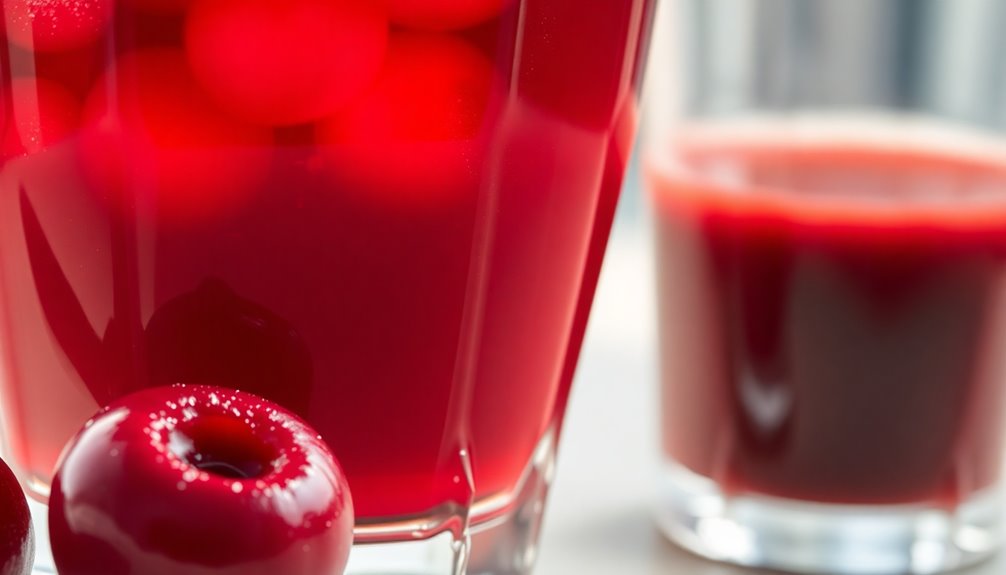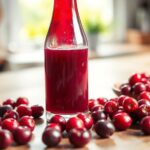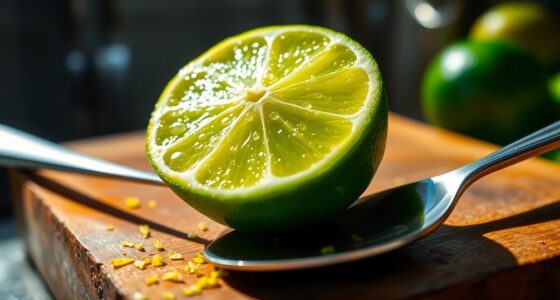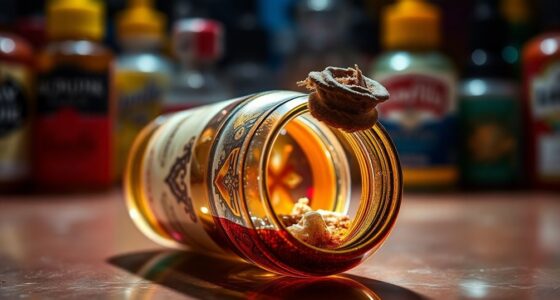To instantly tell if your cranberry juice has gone bad, look for color changes, cloudiness, or sediment. If it smells sour or has a fizzy sensation, it's likely spoiled. Check for bulging or leaking containers, and any floating particles or unusual thickness. If the texture feels off, it's best to discard it. Acting quickly can prevent potential sickness. Keep these tips in mind, and you'll find more helpful insights on maintaining your juice's freshness.
Key Takeaways
- Check for color changes; darkening or cloudiness can indicate spoilage in cranberry juice.
- Look for sediment, bubbles, or a fizzy sensation, which suggest fermentation and spoilage.
- Smell the juice; a sour or fermented odor is a strong indicator that it has gone bad.
- Inspect the container for bulging or leaks, which are clear signs of spoilage.
- Trust your senses; any off texture or visible signs like mold mean the juice is no longer safe to consume.
Understanding the Shelf Life of Cranberry Juice
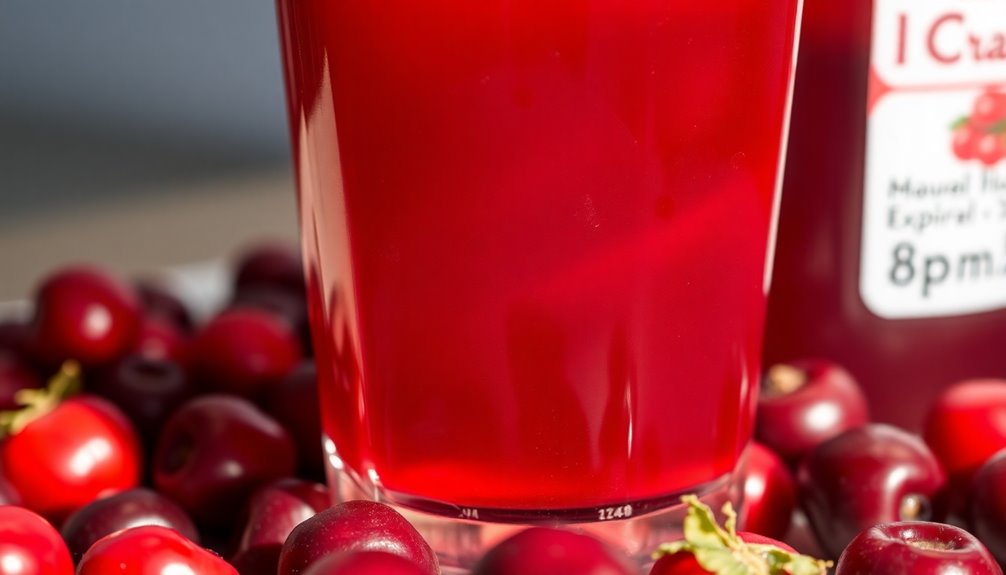
When you're stocking up on cranberry juice, it's important to know how long it'll last. Unopened cranberry juice typically stays fresh for 9-12 months from the production date, especially if it's shelf-stable and stored away from direct sunlight.
While the "best by" date indicates peak quality, the juice can still be good for 3-6 months beyond that date when properly stored.
Once opened, you should refrigerate the juice and expect it to last about 7-10 days. Make sure to keep it in an airtight container at 40°F (4°C) or below to maintain its freshness. Refrigeration is essential after opening to prevent spoilage and ensure safety.
If you want to extend its shelf life, consider freezing it; that way, it can last up to 12 months!
Signs of Spoilage to Look For
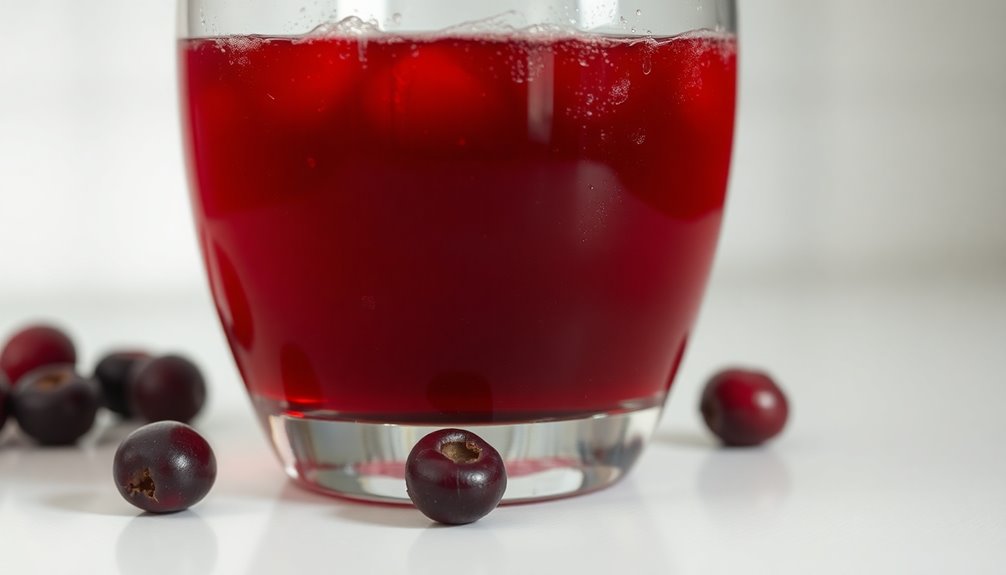
While enjoying your cranberry juice, it's crucial to stay alert for signs of spoilage that could affect its quality and safety.
First, check for color changes; darkening or cloudiness indicates potential problems. Sediment accumulation at the bottom or bubbles on the surface suggests fermentation. If the container is bulging or leaking, that's a clear red flag.
Next, trust your nose. A sour or fermented smell signals spoilage, while a fruity to vinegar-like transition is also concerning. Properly stored juice can remain safe beyond the expiration date, but it's important to check for spoilage signs.
Finally, taste it cautiously. Excessive sourness, a bitter flavor, or a fizzy sensation means it's gone bad. Any slime or stringy particles indicate microbial growth.
If you notice any of these signs, it's best to discard the juice immediately.
The Importance of Proper Storage
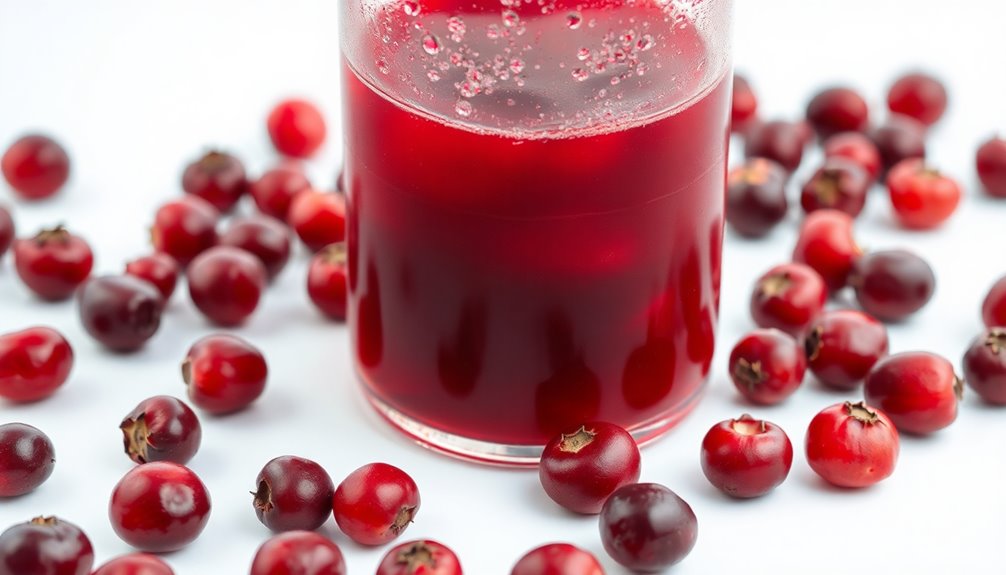
How can proper storage enhance the quality and safety of your cranberry juice? By keeping your juice in a cool, dark place, you can maintain its flavor and nutrients for longer. Sealed jars can sit on your pantry shelf for 12-18 months, but once opened, refrigeration is a must to prevent spoilage. Consistent temperatures slow bacterial growth, ensuring safety and freshness. Additionally, homemade cranberry juice can retain its flavor for the best taste if you wait 4-6 weeks before drinking. Avoid direct sunlight, as it can degrade nutritional value and taste. Use glass jars with tight-fitting lids, and remember to leave headspace to prevent spoilage. Label your jars with dates and inspect them regularly for signs of spoilage. Following these storage guidelines helps you enjoy delicious, safe cranberry juice for as long as possible.
How Temperature Affects Your Juice
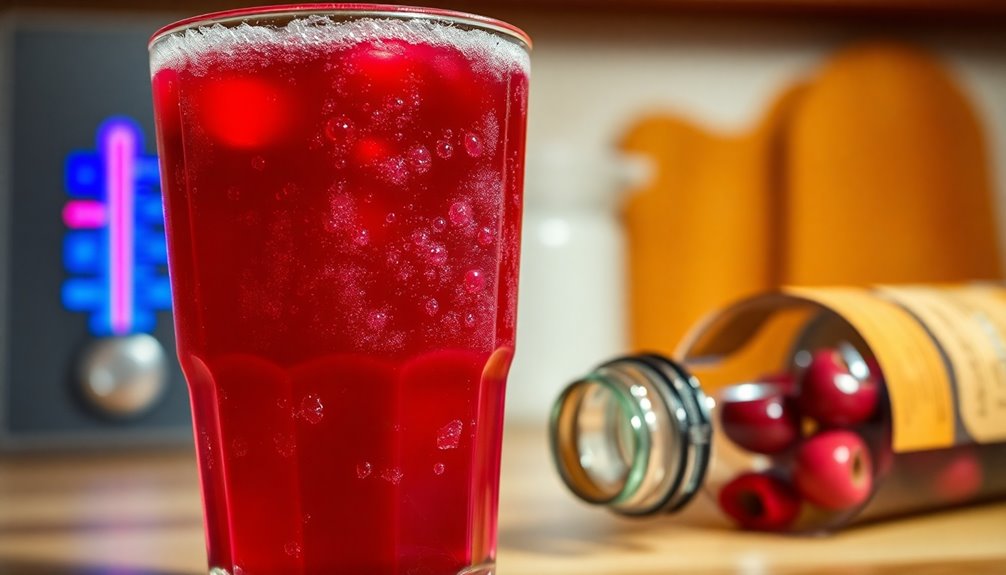
Proper storage is just the beginning of keeping your cranberry juice at its best; temperature plays a vital role too.
Heat can be particularly harmful, causing enzyme deactivation and nutrient loss when temperatures exceed 118°F (47.8°C). This negatively impacts the stability and nutritional value of your juice. Additionally, maintaining lower temperatures can help preserve the antioxidant activity in cranberry juice, which is essential for combating age-related damage. Research shows that pleasant scents can also enhance mood, which may encourage you to enjoy your juice even more.
To preserve essential nutrients like phytochemicals and antioxidants, keep your cranberry juice at lower temperatures.
While some thermal processing methods are common, they can degrade quality and appearance. Non-thermal techniques, like high-pressure processing, can help maintain the juice's nutritional value while ensuring safety.
Recognizing Changes in Color and Appearance
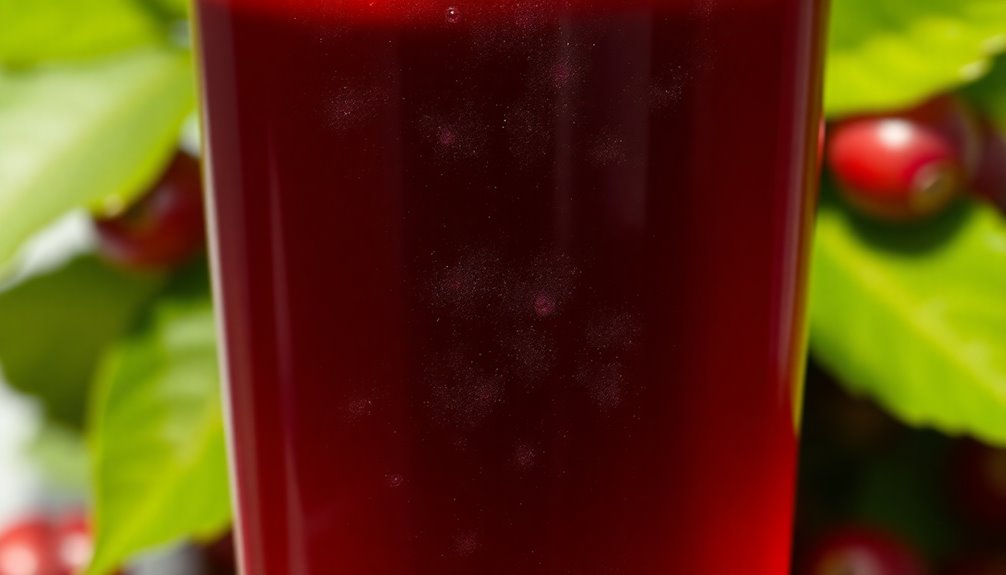
As you examine your cranberry juice, it's crucial to recognize any changes in color and appearance that may signal spoilage. If you notice a darkening of the juice or a shift from vibrant red to a brownish hue, it's time to be cautious. Additionally, the color of cranberry juice can be influenced by white cranberries which are under ripened and typically produce a paler juice. Cloudiness often indicates microbial growth, while visible sediment at the bottom can signal spoilage. Keep an eye out for bubbles or foam, which may suggest fermentation has begun.
Furthermore, mold growth, slime formation, or unusual texture changes are definitive signs of spoilage. Always check for container damage like bulging or leaks, as these can also point to bacterial activity. Maintaining proper storage can help preserve your juice's color and appearance.
Smell: A Key Indicator of Freshness
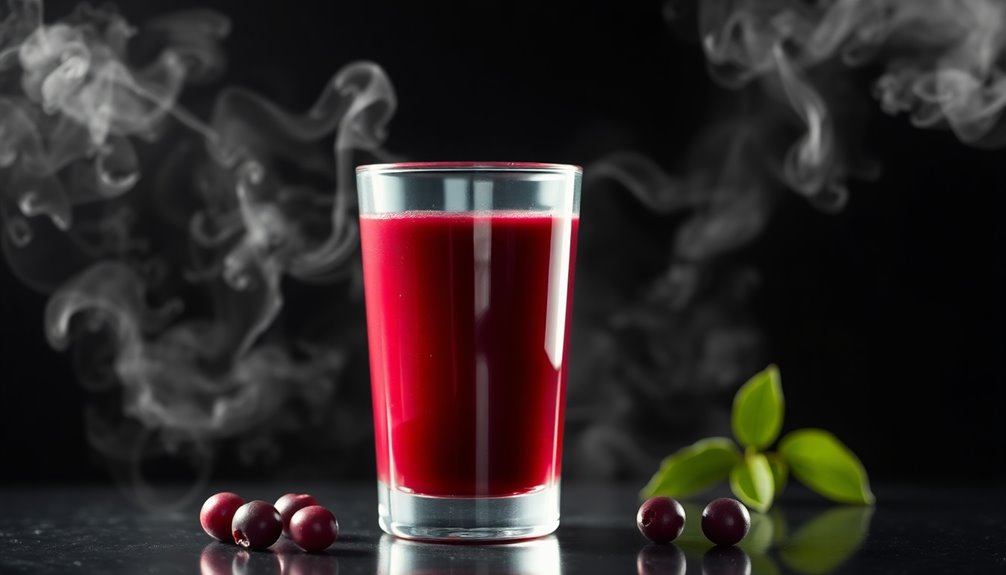
The aroma of cranberry juice serves as a vital indicator of its freshness.
Fresh cranberry juice typically has a crisp, fruity scent that's distinct from other fruit juices. If you notice a sour or fermented smell, it's a clear sign that spoilage has begun. Proper storage is essential to maintain that natural aroma, so always keep it in airtight containers and away from strong-smelling foods. Remember, your juice can absorb odors, affecting its quality. Trust your nose: if the smell deviates from the expected fruity aroma, it's better to discard it. Proper storage techniques help maintain freshness and extend the shelf life of your juice. Additionally, consuming fresh juice can provide nutritional value that is often lost in spoiled products. Smell acts as an early warning system for spoilage, helping you avoid health risks associated with consuming spoiled juice.
Always inspect aroma immediately after opening!
Taste Test: Identifying Spoiled Juice
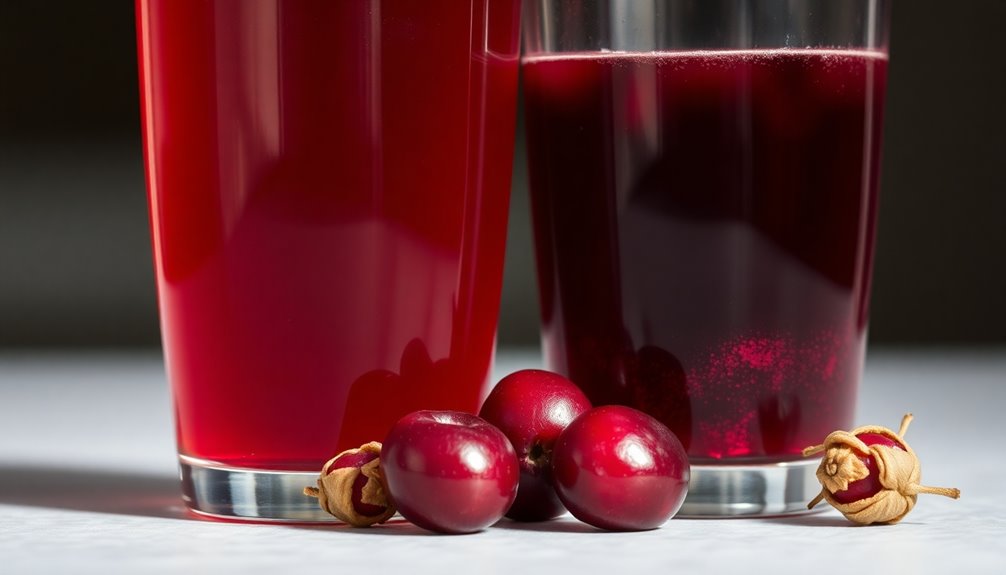
How can you tell if your cranberry juice has gone bad? The taste test is a reliable method. Fresh cranberry juice has a tangy yet balanced flavor, while spoiled juice often tastes unusually sour or off.
If you notice a stark difference in taste, it's a red flag. Remember, improper storage can lead to spoilage, even in unopened bottles, so always inspect your juice before drinking. Drinking spoiled juice can upset your stomach or even cause food poisoning, especially for vulnerable groups. Additionally, expiration dates indicate peak quality but may not reflect immediate safety, so always use your senses to assess freshness.
Also, keep in mind that different brands may have varying levels of tartness and sweetness, so trust your palate when assessing freshness. Always prioritize your health by tasting cautiously!
Texture Changes That Signal Spoilage
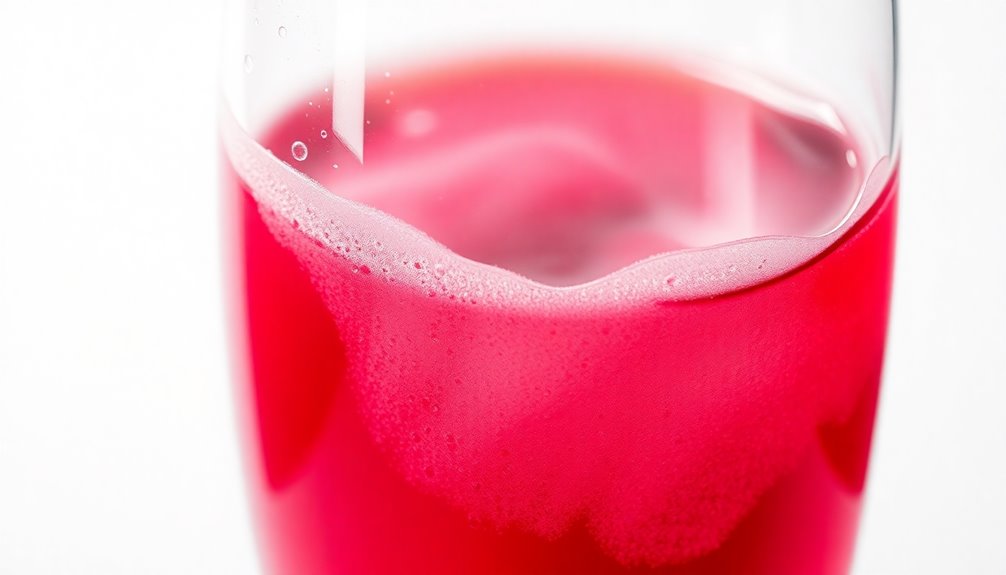
Noticing changes in the texture of your cranberry juice can provide crucial clues about its freshness. If you see sediment accumulating at the bottom, it's a red flag for spoilage. Cloudiness suggests microbial growth, while fizziness or foam may indicate fermentation. If you spot slime, that's a sign of bacterial contamination. Additionally, if the juice feels thicker than usual, it's time to toss it. Always keep an eye out for visible mold or discoloration, as these are definitive spoilage signs. Floating particles and bulging or leaking containers also point to potential issues. Trust your senses—if the texture seems off, it's better to err on the side of caution. This is particularly important in the context of content transmission, as the economic value of your juice diminishes if it is not fresh and safe to consume.
Best Practices for Freezing Cranberry Juice
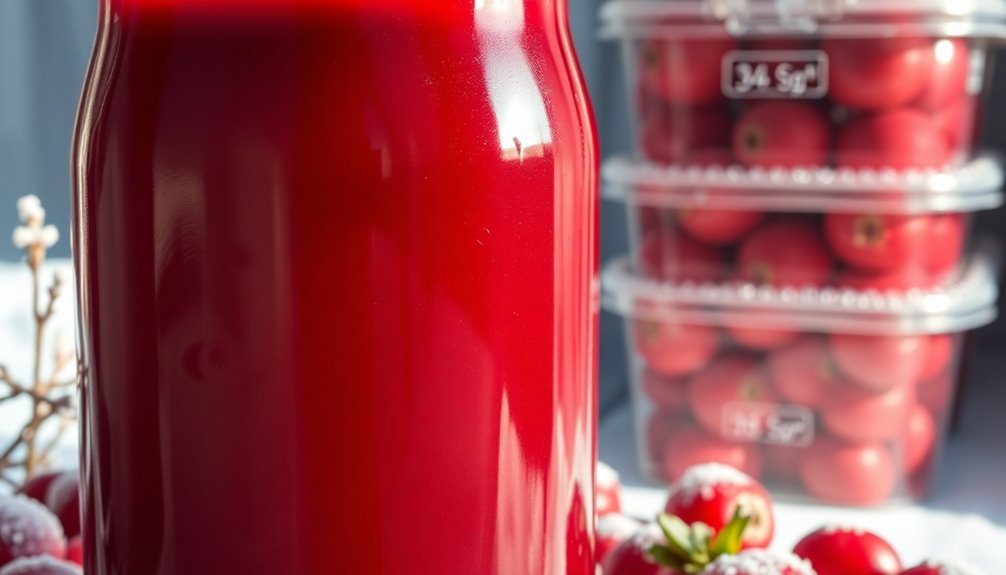
Freezing cranberry juice effectively can extend its shelf life and maintain its flavor. Start by portioning the juice into liquid-safe freezer bags or containers. For convenience, use ice cube trays to freeze small amounts, or muffin trays for larger cubes. Always label your containers with the date and contents to keep track. Remember to leave room for expansion, as liquids expand when frozen. Store the juice for up to 8 months, but it can last a maximum of 12 months. Use freezer-safe bags, and consider double bagging to prevent leaks. Additionally, ensure that you preserve nutrients by avoiding refreezing to maintain quality. When you're ready to enjoy, you can add the frozen juice directly to smoothies or thaw it in the refrigerator for drinking.
Food Safety Tips for Juice Consumption
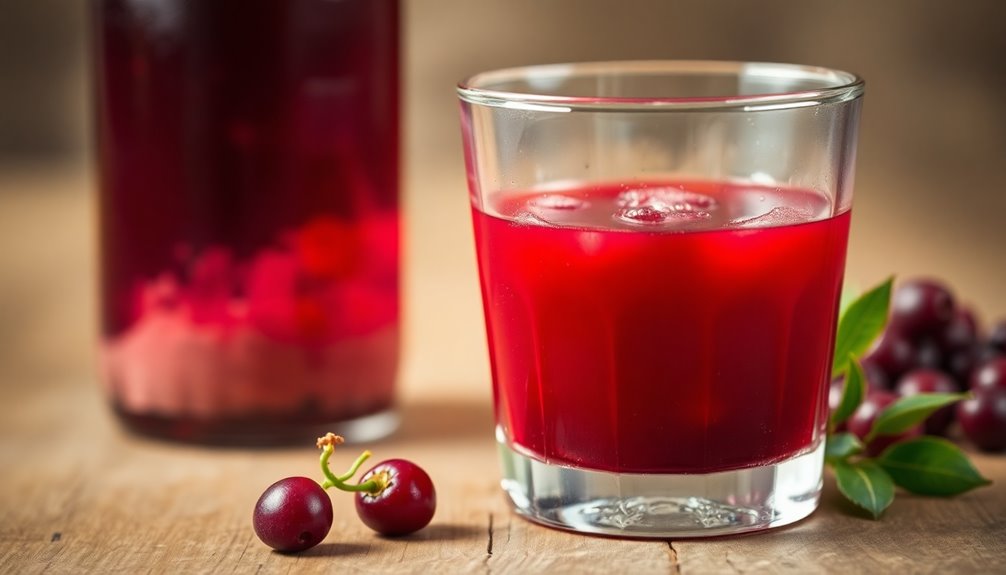
When it comes to enjoying juice safely, following proper food safety tips is crucial to prevent health risks.
Start by washing all fruits and vegetables thoroughly before juicing. Always clean your juicing equipment before and after use to avoid cross-contamination. Juicing removes insoluble fiber, which is important for overall health and nutrient absorption, so be mindful of your overall fiber intake. Additionally, ensure that your juice includes ingredients high in vitamins A, C, and K to enhance its nutritional value.
Once you've made your juice, store it in the refrigerator right away, using airtight containers to minimize air exposure. Be cautious with unpasteurized juices, especially if you're part of a vulnerable group; always check for warning labels.
Never leave juice at room temperature for more than two hours, and consume it by the "use-by" date.
Keep an eye out for spoilage indicators like off odors, visual changes, or odd textures to ensure your juice is safe to drink. Additionally, always store your juice in airtight containers to prevent exposure to air, which can accelerate spoilage. If you’re unsure about the freshness, it’s best to err on the side of caution and discard any questionable juice. For those using an elf bar device, learning how to check your elf bar battery will help ensure your vaping experience is smooth and uninterrupted.
Frequently Asked Questions
Can I Use Expired Cranberry Juice if It Looks Fine?
Using expired cranberry juice that looks fine can be tempting, but it's essential to be cautious.
Even if it seems okay, spoilage signs like off odors or changes in taste mightn't be visible. If it's past the expiration date, consider the risk of foodborne illness.
Always trust your instincts—if you're unsure, it's safer to discard it.
What Should I Do With Leftover Cranberry Juice?
Did you know that 20% of juice goes to waste each year?
If you've got leftover cranberry juice, don't let it go to waste! You can use it in cocktails, mix it into salad dressings, or incorporate it into baked goods for a unique flavor boost.
If you want something different, try making a marinade with it.
Get creative and enjoy every drop of that delicious juice!
Can I Mix Cranberry Juice With Other Juices Safely?
Yes, you can mix cranberry juice with other juices safely, but keep a few things in mind.
Make sure the juices are pasteurized to reduce bacterial risks. Also, watch out for sugar content; blending can increase your intake.
Consider the flavor profile, as cranberry's tartness might overpower sweeter juices.
Always store mixed juices properly in the fridge and check for spoilage signs before consuming.
Enjoy experimenting with combinations that suit your taste!
How Can I Tell if Homemade Cranberry Juice Is Spoiled?
Imagine taking a sip of your homemade cranberry juice, only to be greeted by a sour explosion that makes your taste buds scream!
You can tell if it's spoiled by sniffing for any funky odors, checking for mold or an odd brown tint, and tasting for a sharp, vinegary flavor.
If it feels thick or slimy, toss it out! Spoiled juice isn't just unpleasant; it can also be a health risk you want to avoid!
Is It Safe to Drink Cranberry Juice After It Was Frozen?
Yes, it's safe to drink cranberry juice after it's been frozen, as long as you froze it properly.
Just make sure to thaw it in the refrigerator or cold water to prevent any bacterial growth. Avoid re-freezing thawed juice to maintain its safety and flavor.
If the juice smells sour, looks discolored, or has an unusual texture, it's best to discard it.
Always store it correctly to ensure quality.
Conclusion
In summary, staying savvy about your cranberry juice is essential for safe sipping. Spotting signs of spoilage, storing securely, and savoring the flavor can save you from sour sips. Remember, proper practices like freezing can preserve your juice's potency, while paying attention to color, taste, and texture helps you dodge disaster. So, stay sharp and safeguard your sips to enjoy the delicious, dynamic drink that cranberry juice can be! Cheers to careful consumption!
Susannah expertise lies in researching and compiling evidence-based content on juicing, nutrition, and overall health. She is committed to ensuring that The Juicery World offers accurate, up-to-date, and trustworthy information to empower readers to take control of their health. Susannah’s goal is to inspire individuals to embrace juicing as a way to nourish their bodies and live their best lives.

